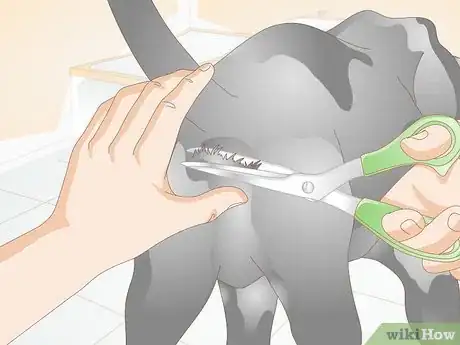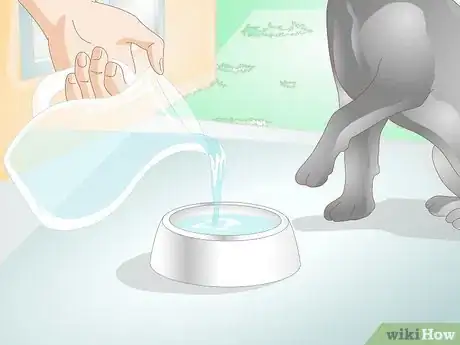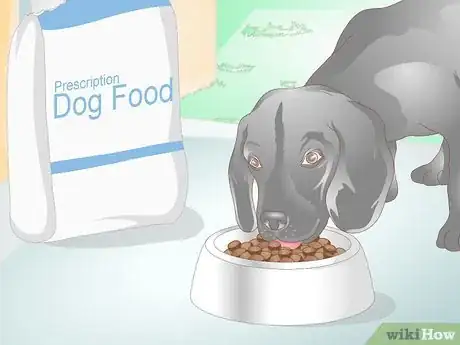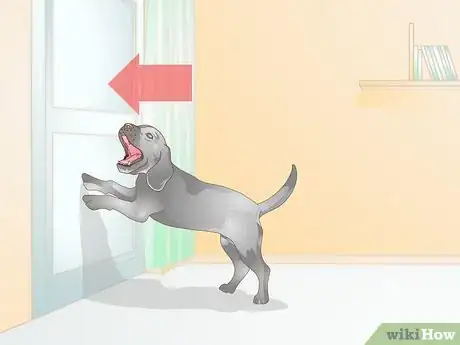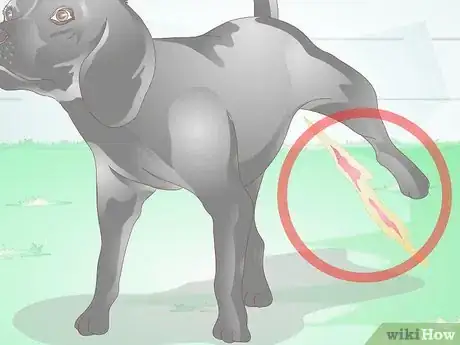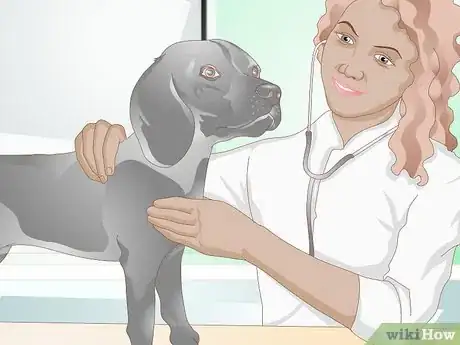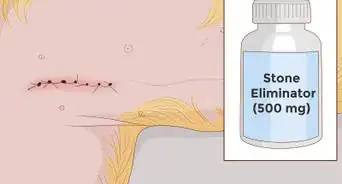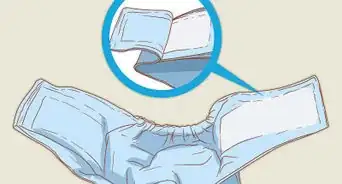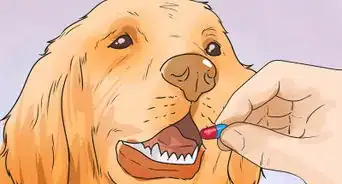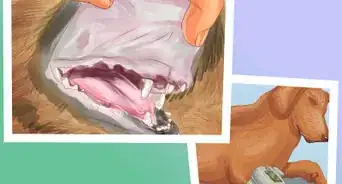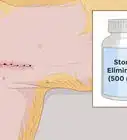This article was co-authored by Ray Spragley, DVM. Dr. Ray Spragley is a Doctor of Veterinary Medicine and the Owner/Founder of Zen Dog Veterinary Care PLLC in New York. With experience in multiple institutions and private practices, Dr. Spragley’s specializations and interests include non-surgical management of cranial cruciate ligament tears, Intervertebral Disk Disease(IVDD), and pain management in osteoarthritis. Dr. Spragley holds a BS in Biology from SUNY Albany and has a Doctor of Veterinary Medicine degree (DVM) from Ross University School of Veterinary Medicine. He is also a Certified Canine Rehabilitation Therapist (CCRT) through the Canine Rehab Institute as well as a Certified Veterinary Acupuncturist (CVA) through Chi University.
wikiHow marks an article as reader-approved once it receives enough positive feedback. In this case, 80% of readers who voted found the article helpful, earning it our reader-approved status.
This article has been viewed 169,978 times.
A urinary tract infection (UTI) in dogs occurs when bacteria infects your dog's immune system. In many cases, UTIs are undetectable in dogs, and sometimes there are no discernible symptoms at all. They can cause pain during urination, though, and lead to other potential health issues. To prevent pain and discomfort in your dog, try to prevent UTIs in the first place.
Steps
Preventing UTIs
-
1Keep your dog well-groomed. You need to keep your pet's rear end as clean as possible. UTIs are more common in females than males because of the vulva's shape and proximity to the anus.[1] Because it's so wide, it's a good entry point for fecal contamination from the anus.
- Whether your pet's male or female, clip the hair around your rear end and genitals.[2] This decreases the chance of feces or bacteria from mud sticking to the dog's private parts.
- If the dog gets mucky, give him a good bath, making sure to clean the fur by the genitals.
-
2Encourage regular urination. The longer urine sits in the bladder, the more chance bacteria have to multiply. Regular urination flushes bacteria out of the bladder, decreasing the chances for an infection.[3] [4] Ideally, your dog should empty his bladder at least every four hours.
- An adult dog can hold his urine for 8 - 10 hours, but that doesn't make it a good idea. Give your dog plenty of opportunities for comfort breaks.
- Let the dog out last thing at night and first thing in the morning to minimize how long he has to hold his urine at night.
Advertisement -
3Provide plenty of clean drinking water. Bacteria make toxins that inflame the bladder lining and let the bacteria attach and invade. If your dog drinks a lot, the water dilutes those toxins, decreasing the chances of getting an infection.[5] [6]
- Make sure all drinking bowls are large, deep, and clean.
- Make sure there's always water in drinking bowls — never let them go dry!
- Clean the bowl daily and completely replace the water.
- If your dog is elderly or stiff on his legs, provide a water bowl in every room.
-
4Don't feed your dog orange juice or other "acidifiers." You may have heard that these are good home remedies for UTIs. In theory, they improve the pH balance in the urine and kill the infection. There is a risk, though, that you'll raise the acid level too high, causing bladder stones instead of a UTI.
- Stick to a prescription diet instead of home remedies. See a veterinarian for advice on how to proceed.
-
5Feed your dog a specialized diet. If your dog is susceptible to UTIs, you might consider asking the vet to prescribe special food. The ideal pH for dog urine is 6.2-6.4. A prescription diet is designed specifically to produce this pH level.
- If you get prescription kibble, encourage the dog to drink water by leaving bowls in multiple locations, freely available.
- Wet prescription food will have more moisture than kibble, and help hydrate your dog even more. Wet food containers take up a lot of space, though, and wet food usually results in smellier feces.
Recognizing and Reacting to a UTI
-
1Watch for increased urgency of urination.[7] This might mean that your dog asks to be let out more frequently. He may also be more insistent, as though every time is an emergency. Increased urgency is a tell-tale sign of UTI.
- You might also notice repeated urinating behavior (squatting or leg-cocking) without urination. The dog might feel like he or she needs to urinate, but be unable to urinate when let outside.
-
2Look for blood in the urine.[8] This might be hard, as dogs usually urinate onto grass. If you suspect your dog might have a UTI, though, watch the urine stream mid-air, before it hits the ground. If it looks like it has blood in it, take the dog to the veterinarian immediately.
-
3Have older dogs tested regularly. Older dogs with health issues like kidney disease or diabetes tend to drink more water to deal with their condition. This can lead to "subclinical infections" due to increased urination. There's bacteria present, but not enough to cause observable signs of discomfort.
- The only way to test for a subclinical infection is having a vet test a urine sample. Some vets recommend doing this as part of older dogs' regular medical routines.
- If your dog has a history of subclinical infections, have its urine tested every three to six months.
-
4Take the dog to the vet if you suspect a UTI. The "infection" part of UTI signals the presence of an infectious agent like bacteria. This needs medical treatment, so you need to take your pet to the vet as soon as possible. If you can, collect a sample of the dog's urine to take with you, as this may speed up the diagnosis.
-
5Have a veterinarian address repeated infections. If you're taking steps to keep UTIs at bay, but your dog keeps getting them, they might be an underlying health problem. This problem may be weakening your dog's immune system or bladder tissue, resulting in increased UTIs. Identifying and treating the problem will reduce the chance of UTI. Ask your vet to run tests to identify potential causes for your dog's problems.[9] This might include:
- Blood tests: The vet can check for conditions that may make the dog drink more and have weaker urine (kidney, liver disease, diabetes)
- Imaging: An ultrasound can check for the presence of polyps, bladder cancer, bladder stones, and other issues which can affect the bladder lining.
- Urine sediment exam: The veterinarian urine sediment under a microscope for crystals that might explain the dog's issues.
Expert Q&A
-
QuestionHow does a dog get a UTI?
 Ray Spragley, DVMDr. Ray Spragley is a Doctor of Veterinary Medicine and the Owner/Founder of Zen Dog Veterinary Care PLLC in New York. With experience in multiple institutions and private practices, Dr. Spragley’s specializations and interests include non-surgical management of cranial cruciate ligament tears, Intervertebral Disk Disease(IVDD), and pain management in osteoarthritis. Dr. Spragley holds a BS in Biology from SUNY Albany and has a Doctor of Veterinary Medicine degree (DVM) from Ross University School of Veterinary Medicine. He is also a Certified Canine Rehabilitation Therapist (CCRT) through the Canine Rehab Institute as well as a Certified Veterinary Acupuncturist (CVA) through Chi University.
Ray Spragley, DVMDr. Ray Spragley is a Doctor of Veterinary Medicine and the Owner/Founder of Zen Dog Veterinary Care PLLC in New York. With experience in multiple institutions and private practices, Dr. Spragley’s specializations and interests include non-surgical management of cranial cruciate ligament tears, Intervertebral Disk Disease(IVDD), and pain management in osteoarthritis. Dr. Spragley holds a BS in Biology from SUNY Albany and has a Doctor of Veterinary Medicine degree (DVM) from Ross University School of Veterinary Medicine. He is also a Certified Canine Rehabilitation Therapist (CCRT) through the Canine Rehab Institute as well as a Certified Veterinary Acupuncturist (CVA) through Chi University.
Veterinarian One possibility is that bacteria got caught in the fur around your dog's genitals. Give their coat a trim to make sure nothing gets caught around the area.
One possibility is that bacteria got caught in the fur around your dog's genitals. Give their coat a trim to make sure nothing gets caught around the area. -
QuestionDoes a UTI come from within, or outside contact?
 Pippa Elliott, MRCVSDr. Elliott, BVMS, MRCVS is a veterinarian with over 30 years of experience in veterinary surgery and companion animal practice. She graduated from the University of Glasgow in 1987 with a degree in veterinary medicine and surgery. She has worked at the same animal clinic in her hometown for over 20 years.
Pippa Elliott, MRCVSDr. Elliott, BVMS, MRCVS is a veterinarian with over 30 years of experience in veterinary surgery and companion animal practice. She graduated from the University of Glasgow in 1987 with a degree in veterinary medicine and surgery. She has worked at the same animal clinic in her hometown for over 20 years.
Veterinarian It can be either. Dogs kept in dirty conditions are more prone to UTIs which track upward from bacteria and dirt that contaminates their private parts. However, dogs with bladder stones or crystals in their urine can develop a secondary infection due to irritation and chafing by the stones.
It can be either. Dogs kept in dirty conditions are more prone to UTIs which track upward from bacteria and dirt that contaminates their private parts. However, dogs with bladder stones or crystals in their urine can develop a secondary infection due to irritation and chafing by the stones. -
QuestionAre there certain foods that can lead to a urinary tract infection?
 Pippa Elliott, MRCVSDr. Elliott, BVMS, MRCVS is a veterinarian with over 30 years of experience in veterinary surgery and companion animal practice. She graduated from the University of Glasgow in 1987 with a degree in veterinary medicine and surgery. She has worked at the same animal clinic in her hometown for over 20 years.
Pippa Elliott, MRCVSDr. Elliott, BVMS, MRCVS is a veterinarian with over 30 years of experience in veterinary surgery and companion animal practice. She graduated from the University of Glasgow in 1987 with a degree in veterinary medicine and surgery. She has worked at the same animal clinic in her hometown for over 20 years.
Veterinarian Indirectly, yes. Some dogs develop crystals in their urine or bladder stones as a result of the minerals in food interacting with their body chemistry. This means some dogs should avoid eating certain foods that are rich in those minerals. It is impossible to give a general rule as to what to avoid, as each dog is different.
Indirectly, yes. Some dogs develop crystals in their urine or bladder stones as a result of the minerals in food interacting with their body chemistry. This means some dogs should avoid eating certain foods that are rich in those minerals. It is impossible to give a general rule as to what to avoid, as each dog is different.
References
- ↑ Recurrent and persistent urinary tract infections in dogs. Norris & Williams JAAHA 35.
- ↑ Ray Spragley, DVM. Veterinarian. Expert Interview. 31 March 2021.
- ↑ Ray Spragley, DVM. Veterinarian. Expert Interview. 31 March 2021.
- ↑ Small Animal Internal Medicine. Nelson & Couto. Publisher: Mosby
- ↑ Ray Spragley, DVM. Veterinarian. Expert Interview. 31 March 2021.
- ↑ Recurrent and persistent urinary tract infections in dogs. Norris & Williams JAAHA 35.
- ↑ Small Animal Internal Medicine. Nelson & Couto. Publisher: Mosby
- ↑ Small Animal Internal Medicine. Nelson & Couto. Publisher: Mosby
- ↑ Ray Spragley, DVM. Veterinarian. Expert Interview. 31 March 2021.
About This Article
To prevent UTIs in your dog, provide it with plenty of fresh drinking water to dilute the toxins that can inflame the bladder lining. Additionally, let your dog out every few hours so it can flush the bacteria out of its bladder by urinating. After your dog relieves itself, check its rear end and genitals to make sure they’re clean, since contamination from feces or mud is a common source of UTIs in dogs. You can also try asking your vet for a prescription dog food designed to prevent UTIs by raising your dog’s pH level. For more advice from our Veterinary co-author, like how to recognize the signs of a UTI in your dog, keep reading.
